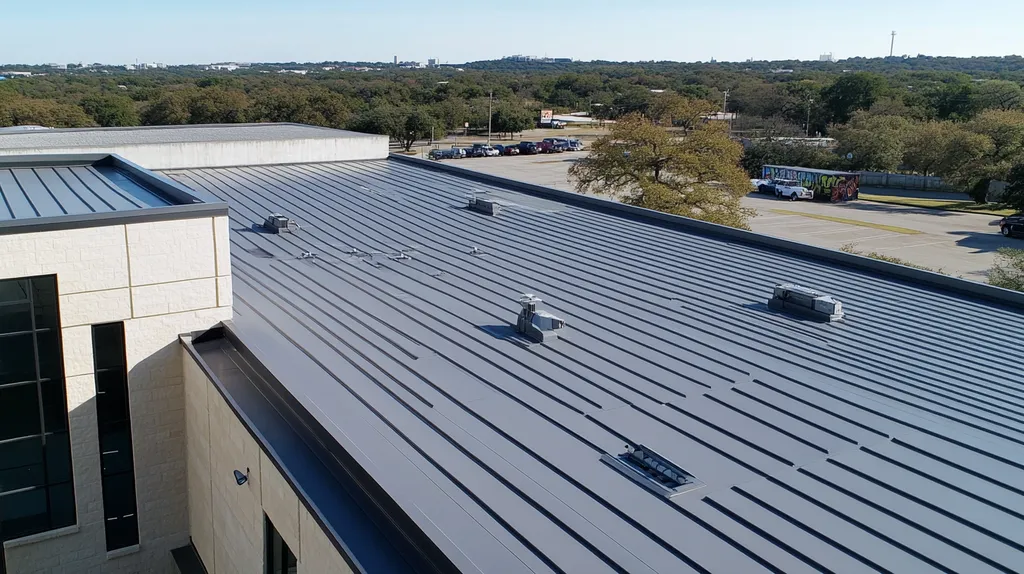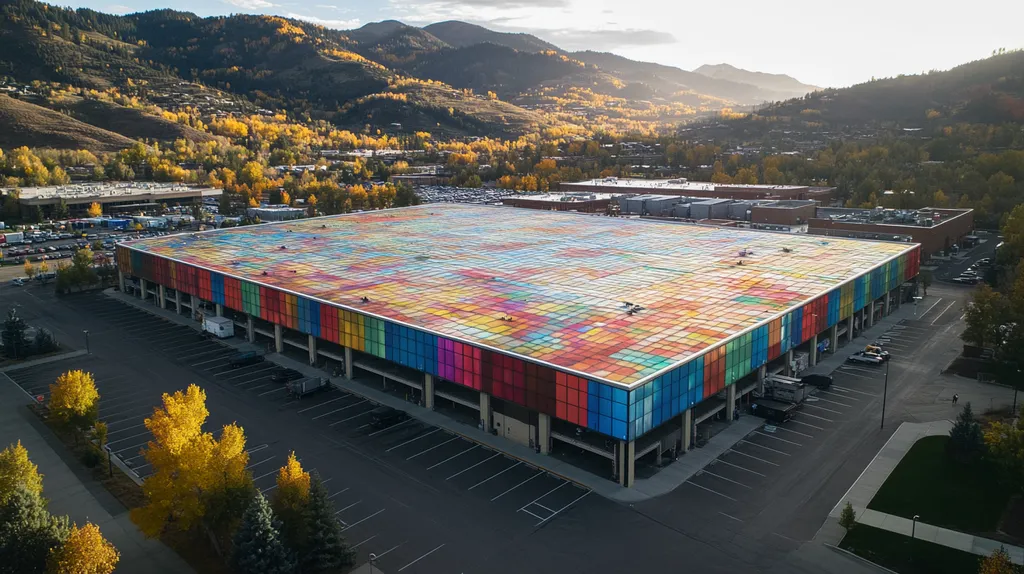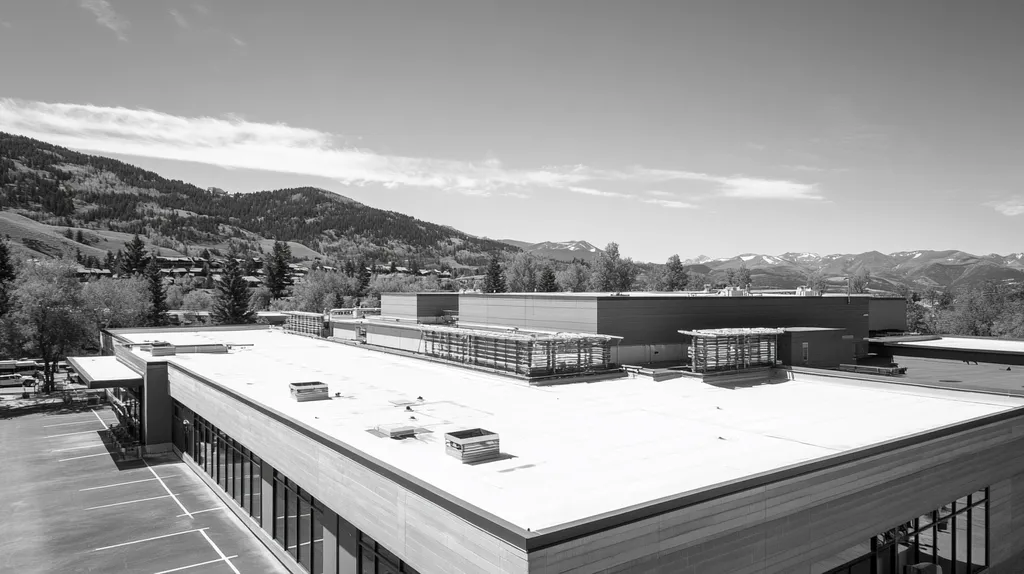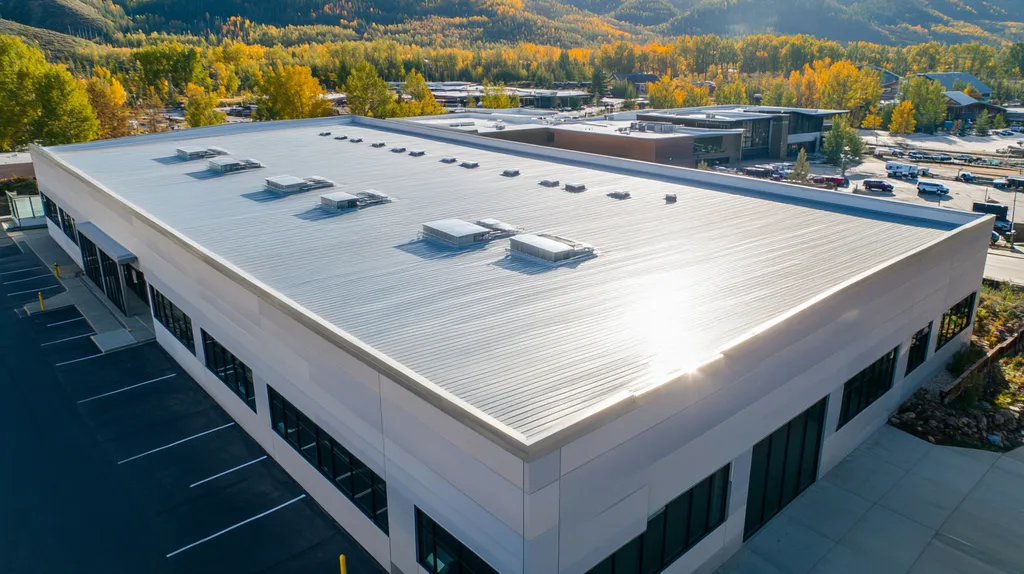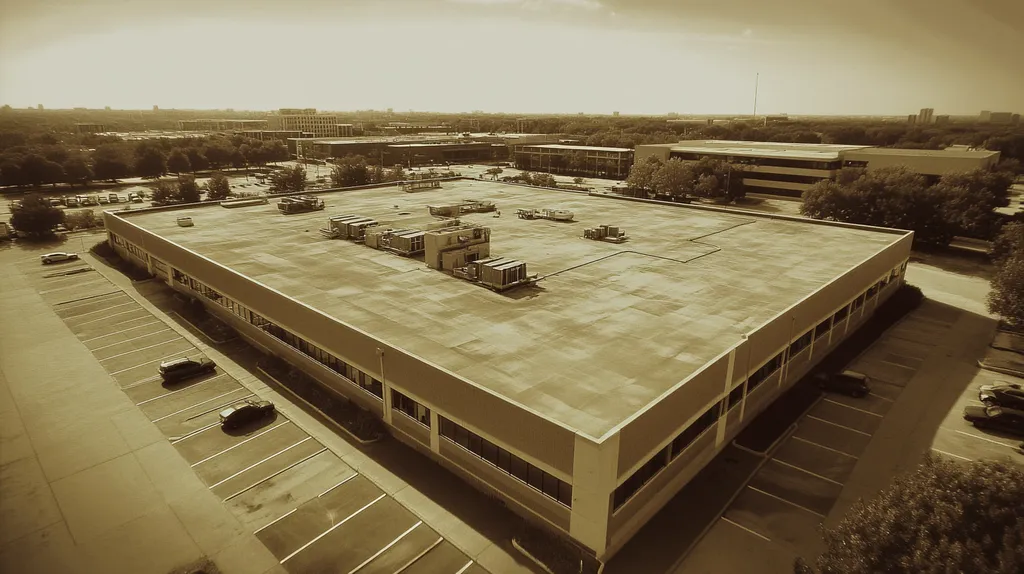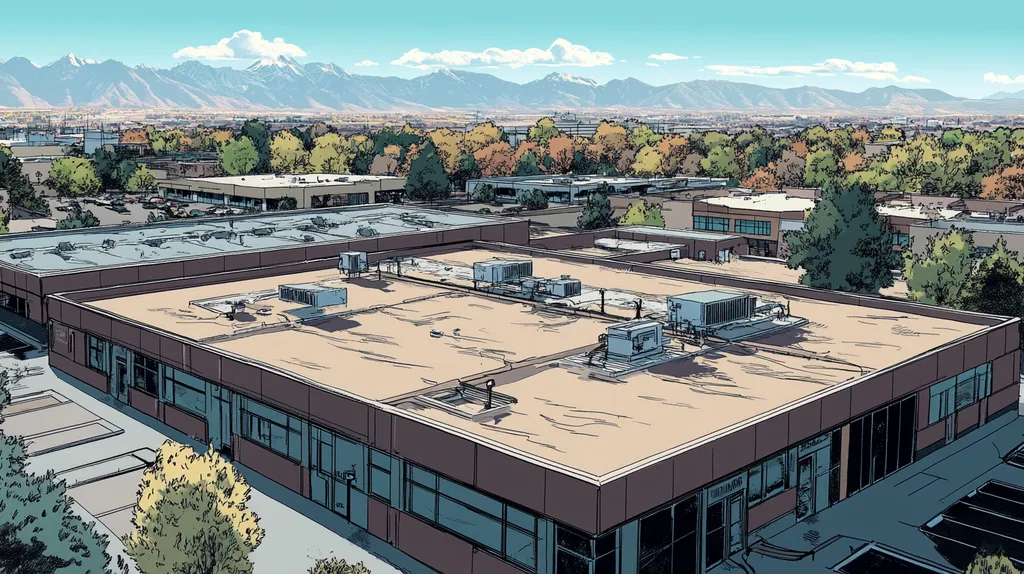Commercial property owners lose over $3.2 billion annually due to improper roof coating selections that fail to account for local climate conditions.
As extreme weather events intensify and energy costs soar, the stakes for choosing appropriate roofing solutions have never been higher.
This comprehensive analysis examines persistent myths about commercial roof coatings while providing evidence-based guidance for selecting climate-appropriate systems that maximize protection and minimize long-term costs.
By understanding the true capabilities and limitations of modern coating technologies, facility managers can make informed decisions that extend roof life, reduce energy consumption, and protect their valuable building assets.
SECTION 1: COMMON MISCONCEPTIONS
Every year, commercial property owners waste millions of dollars on ineffective or inappropriate roof coatings due to widespread misconceptions about their application and performance. These costly mistakes not only strain maintenance budgets but can lead to premature roof failure, disrupting business operations and compromising building integrity. Understanding the truth behind common coating myths is essential for making informed decisions that protect both facilities and bottom lines.
Myth: All Roof Coatings Perform Equally
The reality of roof coating performance varies dramatically based on chemical composition and application environment. Each coating type possesses distinct characteristics that determine its effectiveness in specific situations.
Silicone coatings provide superior ponding water resistance and UV protection, making them ideal for flat roofs in sunny climates. However, they may have adhesion limitations on certain surfaces.
Acrylic coatings offer excellent reflectivity and cost-effectiveness but may not perform well in areas with frequent rainfall or extreme temperature fluctuations.
Polyurethane coatings deliver outstanding durability and chemical resistance, though they typically come with higher material costs and more complex application requirements.
Myth: Coatings Are Ineffective in Harsh Climates
Modern coating technologies have evolved to meet the challenges of extreme weather conditions. Advanced formulations now provide reliable protection in environments ranging from desert heat to arctic cold.
High-performance coatings can expand and contract with temperature changes while maintaining their protective properties. This flexibility prevents cracking and delamination even in severe thermal cycling.
Specialized cold-weather coatings incorporate anti-freeze properties and moisture-resistant compounds, ensuring effectiveness even in sub-zero temperatures and heavy precipitation.
Heat-resistant formulations with ceramic additives can reduce roof surface temperatures by up to 80 degrees Fahrenheit, significantly improving building energy efficiency.
Myth: Metal Roofs Cannot Be Coated
Metal roofs are actually excellent candidates for coating systems, often experiencing some of the most dramatic performance improvements. Modern coatings can effectively seal seams, protect against rust, and extend metal roof lifespans.
Purpose-designed metal roof coatings contain rust inhibitors and adhesion promoters that bond directly to properly prepared metal surfaces, creating a seamless protective barrier.
These specialized coatings can reduce thermal movement stress by limiting heat absorption, which helps prevent fastener loosening and maintains structural integrity.
When properly applied, metal roof coatings can add 10-15 years to roof life while improving energy efficiency through enhanced reflectivity and insulation properties.
SECTION 2: PRACTICAL IMPLICATIONS
The consequences of improper roof coating decisions ripple throughout a building’s entire operational lifecycle. Recent industry data shows that up to 40% of commercial roof failures stem from mismatched coating selections, leading to premature degradation and excessive energy costs. For facility managers, understanding the practical implications of coating choices is not just about maintenance – it’s about protecting critical assets and ensuring sustainable building performance.
Impact of Climate on Coating Selection
Regional climate conditions fundamentally shape coating performance requirements. Hot, sunny environments demand high solar reflectivity and UV resistance to prevent premature membrane degradation and reduce cooling loads.
Coastal areas require enhanced corrosion resistance and superior adhesion properties to combat salt spray and high humidity. These environments can accelerate coating breakdown without proper chemical formulation.
Facilities in northern regions need coatings that maintain flexibility in sub-zero temperatures while resisting ice damage. Standard coatings can become brittle and crack under severe thermal cycling.
Areas with frequent rainfall or prolonged moisture exposure require coatings with superior water resistance and anti-fungal properties. The wrong coating choice in these conditions can lead to widespread membrane deterioration.
Effects of Improper Coating Application
Surface preparation quality directly impacts coating adhesion and longevity. Insufficient cleaning, improper primers, or rushed application can reduce coating effectiveness by up to 70% and void manufacturer warranties.
Temperature and humidity during application critically affect coating cure times and final performance. Application outside manufacturer-specified conditions often results in blistering, delamination, and premature failure.
Incorrect coating thickness leads to inadequate protection and accelerated wear. Too thin, and the coating won’t provide adequate protection; too thick, and it may crack or separate from the substrate.
Poor detail work around penetrations, flashings, and transitions creates vulnerable points for moisture infiltration. These areas require extra attention and often specialized application techniques.
Long-Term Durability and Weather Resistance
Modern coating systems must demonstrate multi-decade performance under increasingly extreme weather conditions. High-performance coatings can extend roof service life by 15-20 years when properly specified and maintained.
Weather resistance capabilities vary significantly between coating types. Premium formulations offer superior resistance to UV degradation, chemical exposure, and physical impact.
Regular inspection and maintenance programs significantly impact coating longevity. Early detection of coating deterioration allows for targeted repairs before extensive damage occurs.
Environmental stressors like acid rain, industrial emissions, and biological growth can accelerate coating breakdown. Understanding local environmental challenges helps inform proper coating selection and maintenance intervals.
Coating durability directly affects building energy performance. Well-maintained reflective coatings can reduce peak roof temperatures by up to 80°F and cut cooling costs by 25-35% compared to uncoated surfaces.
SECTION 3: COST OF MISINFORMATION
Misinformation about commercial roof coatings costs facility owners billions annually in preventable expenses. When multiplied across the commercial real estate sector, poor coating decisions lead to widespread waste of resources, shortened roof lifespans, and skyrocketing energy costs. Beyond the immediate financial impact, these mistakes create a ripple effect of increased maintenance demands, business disruptions, and environmental burden.
Financial Risks of Choosing Wrong Coatings
Selecting an incompatible coating system often triggers a cascade of unexpected costs that can devastate maintenance budgets. What begins as a seemingly minor coating mismatch can escalate into structural damage requiring extensive repairs or premature roof replacement.
Wrong coating choices frequently void existing roof warranties, leaving property owners fully exposed to repair costs. These warranty issues become particularly problematic when dealing with hybrid roofing systems or modified bitumen installations.
The financial impact extends beyond the roof itself to interior damage from water infiltration. A single coating failure can lead to damaged inventory, interrupted operations, and potential liability issues.
Many facility managers discover too late that attempting to correct a coating mistake costs 3-4 times more than proper initial application. This includes removal of the failed coating, substrate repairs, and new coating application.
Expense of Premature Roof Repairs and Replacements
Premature coating failure forces facility managers into an expensive cycle of reactive maintenance rather than planned preservation. Each emergency repair diverts resources from other critical facility needs while potentially compromising roof integrity.
The true cost of accelerated repairs includes both direct expenses and operational disruptions. Weekend and after-hours emergency work often commands premium rates, while business interruptions can exceed the actual repair costs.
Coating failures typically reduce overall roof lifespan by 40-60%, forcing early replacement of otherwise sound roofing systems. This compressed replacement timeline creates serious budget planning challenges for facility managers.
The cumulative cost of repeated repairs often exceeds the price of complete roof replacement, yet budget constraints frequently prevent taking this more cost-effective long-term approach.
Hidden Costs from Energy Inefficiency
Inappropriate coating selections can increase HVAC loads by 20-35%, creating an ongoing drain on operational budgets. This impact becomes particularly severe during peak cooling and heating seasons when energy demands are highest.
Poor coating choices often compromise the building’s thermal performance by reducing solar reflectivity and emissivity. The resulting heat gain drives up cooling costs while accelerating roof membrane degradation.
Many facility managers overlook how coating degradation progressively reduces energy efficiency over time. What starts as a minor increase in energy usage can expand into significant cost escalation within just 2-3 years.
Buildings with compromised coating systems typically require larger HVAC systems to maintain desired indoor temperatures. This equipment oversizing creates additional capital costs while reducing overall system efficiency.
The environmental impact of increased energy consumption extends beyond direct costs to affect corporate sustainability goals and compliance with energy efficiency regulations.
SECTION 4: REALITY CHECK
Misaligned coating choices cost commercial property owners millions in premature failures and excessive energy consumption each year. The complexity of modern coating systems, combined with diverse climate challenges across regions, demands a more nuanced approach than the traditional “one-size-fits-all” mentality. Understanding the distinct characteristics of different coating types and their performance in specific environments has become crucial for protecting valuable roofing assets.
Differentiating Acrylic, Silicone, and Polyurethane Coatings
Acrylic coatings stand out for their exceptional UV protection and reflectivity properties, making them particularly effective in regions with high sun exposure. Their cost-effective nature and ease of application have made them a popular choice for many commercial properties.
Silicone coatings excel in environments where ponding water poses a significant challenge, offering superior resistance to moisture accumulation on flat or low-slope roofs. Their weather-resistant properties make them ideal for areas with frequent rainfall or high humidity.
Polyurethane coatings come in two distinct varieties: aromatic and aliphatic. Aromatic formulations serve effectively as base coats, while aliphatic versions provide superior top-coat protection against environmental stressors.
The selection process must carefully weigh climate conditions, roof configuration, and budget constraints to achieve optimal protection and longevity. (source: Lakes Country Roofing Blog)
Understanding Coating Performance in Various US Climates
Coastal environments demand coatings with enhanced resistance to salt spray and constant moisture exposure. These harsh conditions can accelerate coating breakdown without proper chemical formulation and application methods.
Desert and high-altitude regions require coatings that can withstand intense UV exposure and dramatic temperature fluctuations. Standard formulations often fail prematurely in these extreme conditions, leading to costly repairs.
Northern regions present unique challenges with freeze-thaw cycles and snow accumulation. Coatings must maintain flexibility at low temperatures while resisting ice damage and thermal shock.
Urban environments expose roofs to additional stressors including industrial emissions and chemical pollutants. These factors necessitate specialized coating formulations with enhanced chemical resistance properties.
The Role of Roof Maintenance After Coating Application
Regular inspection protocols must include detailed assessment of coating integrity, particularly around roof penetrations and transition areas. These vulnerable points often show the first signs of coating degradation or failure.
Maintenance teams should document coating performance through systematic monitoring and photography. This documentation helps track degradation patterns and optimize future maintenance scheduling.
Cleaning protocols must align with coating manufacturer specifications to prevent inadvertent damage. Harsh cleaning agents or improper pressure washing can compromise coating integrity and void warranties.
Environmental debris management becomes critical for maintaining coating effectiveness. Regular removal of leaves, branches, and other debris prevents moisture retention and chemical degradation of the coating surface.
Annual coating assessment should include adhesion testing and thickness measurements at representative locations. These metrics provide early warning of potential system failures and guide preventive maintenance efforts.
SECTION 5: EVIDENCE-BASED ALTERNATIVES
Commercial roofing decisions today require moving beyond traditional approaches to embrace data-driven coating solutions. Studies show that up to 70% of roof coating failures stem from mismatched applications that ignore critical performance metrics. By focusing on measurable coating characteristics and documented performance data, facility managers can dramatically improve roof longevity while reducing long-term costs.
Selecting Coatings Based on Reflectivity and UV Resistance
Solar reflectivity ratings provide concrete measurements for comparing coating performance. High-performance coatings can reflect up to 85% of solar radiation, translating to roof surface temperature reductions of up to 50°F during peak summer conditions.
UV resistance capabilities must be evaluated through standardized testing protocols. Premium coatings maintain their protective properties for 15-20 years under intense UV exposure, while standard formulations may degrade within 5-7 years.
Emissivity values determine how effectively coatings release absorbed heat. Coatings with emissivity ratings above 0.85 can reduce cooling costs by 20-30% compared to traditional roofing materials.
Temperature cycling resistance becomes critical as climate extremes intensify. Advanced coating formulations can withstand daily temperature fluctuations exceeding 100°F without cracking or delaminating.
Using Specialty Coatings for Ponding Water and Physical Stress
Ponding water resistance requires specific chemical properties that maintain coating integrity under constant moisture exposure. High-performance moisture-resistant coatings can withstand continuous water immersion for up to 72 hours without degradation.
Impact resistance metrics help identify coatings suitable for high-traffic areas. Premium formulations can withstand repeated impact from maintenance activities while maintaining their protective properties.
Chemical resistance becomes essential near HVAC equipment and exhaust vents. Specialized coatings incorporate acid-resistant compounds that prevent degradation from industrial emissions and chemical fallout.
Tensile strength and elongation properties determine a coating’s ability to bridge developing cracks. Advanced formulations can stretch up to 300% while maintaining their protective barrier.
Tailored Coating Systems for Specific Roofing Materials
Single-ply membrane coatings require careful attention to surface compatibility and adhesion strength. Modern coating systems can achieve pull-off adhesion values exceeding 300 psi when properly matched to membrane chemistry.
Metal roof coatings must address thermal movement and corrosion protection. Advanced metal coating systems incorporate rust-inhibiting compounds while providing movement capability up to 180% of original dimensions.
Modified bitumen and built-up roofing systems need coatings that can conform to irregular surfaces. Specialized coating formulations achieve superior adhesion by penetrating surface irregularities while maintaining consistent mil thickness.
Concrete deck coatings must address both waterproofing and structural movement. High-build systems can bridge hairline cracks while providing compressive strength ratings over 400 psi.
SECTION 6: TEST AND VERIFY
The stakes for commercial roof coating integrity have never been higher. Recent industry data reveals that undetected coating failures cost facility owners over $4.2 billion annually in emergency repairs and business disruptions. While 85% of catastrophic roof failures show early warning signs, most go unnoticed due to inadequate testing and verification protocols. Understanding and implementing proper assessment methods has become crucial for protecting valuable roofing investments and ensuring business continuity.
Methods to Assess Roof Coating Integrity
Digital coating thickness gauges provide precise measurements across roof surfaces, identifying areas of premature wear or improper application. Regular thickness monitoring helps predict coating lifespan and optimize maintenance schedules.
Adhesion testing using standardized pull-off methods reveals the coating’s bond strength to the substrate. This critical data helps facility managers anticipate potential delamination issues before visible signs appear.
Moisture scanning with nuclear gauges or infrared equipment can detect subsurface water accumulation that threatens coating performance. Early detection of moisture intrusion prevents extensive membrane damage and costly repairs.
Surface profile analysis using comparative methods ensures proper texture for optimal coating adhesion. Inadequate surface preparation remains the leading cause of premature coating failure.
Technologies for Leak Detection and Monitoring
Electronic leak detection (ELD) systems use low-voltage current to pinpoint breaches in the coating membrane. This non-destructive testing method can locate leaks with centimeter accuracy, even in completely dry conditions.
Automated monitoring systems with embedded sensors provide 24/7 oversight of coating performance. These systems track temperature, moisture, and membrane movement while alerting facility managers to developing issues.
Thermographic imaging reveals temperature variations that indicate moisture infiltration or insulation failures. Regular thermal surveys can identify problem areas before visible damage occurs.
Advanced drone systems equipped with multispectral cameras create detailed coating condition maps. This technology allows safe inspection of difficult-to-access areas while providing comprehensive documentation.
Best Practices for Routine Roof Inspection and Verification
Comprehensive inspection protocols must address specific climate-related challenges that affect coating performance. Different roofing materials and local weather patterns require tailored assessment approaches to ensure long-term protection.
Modern coating systems demand climate-specific testing frequencies and methods. TPO roofing in high-temperature regions requires more frequent UV degradation assessment, while EPDM installations in moderate climates need focused moisture resistance verification. (source: Parsons Roof)
Documentation systems must track coating performance metrics over time. Establishing performance baselines and monitoring degradation rates helps optimize maintenance timing and budget allocation.
Quality control measures should include third-party verification of coating application and performance. Independent assessment provides unbiased confirmation of installation quality and ongoing protective capabilities.
Emergency response protocols need integration with verification systems. Rapid assessment capabilities following severe weather events help prevent minor coating damage from escalating into major failures.
The Bottom Line
Commercial property owners lose over $3.2 billion annually to improper roof coating decisions, yet this costly burden remains largely preventable through evidence-based selection and verification.
As extreme weather events intensify and energy costs continue rising, choosing appropriate coating systems has become a critical factor in building sustainability and asset protection.
The data clearly shows that climate-appropriate coating selection, combined with rigorous testing protocols, can extend roof life by 15-20 years while reducing energy costs by up to 40%.
Moving forward, facility managers must embrace modern coating technologies and verification methods to protect their investments against increasingly challenging environmental conditions.
The future of commercial roofing depends on replacing outdated myths with data-driven solutions that deliver documented performance in specific climate zones.
FREQUENTLY ASKED QUESTIONS
Q. What are common misconceptions about commercial roofs?
A. Many believe all roof coatings perform uniformly, leading to poor selections. The truth is, each type has unique features that affect performance based on environmental conditions. Choosing the right coating is essential to avoid wasted resources and ensure a long-lasting roof.
Q. How does climate affect commercial roof coating choices?
A. Regional climate directly influences roof coating performance. Facilities in sunny areas need coatings that reflect UV rays, while coastal places require moisture-resistant options. In northern climates, coatings must withstand freezing temperatures. Choosing based on climate helps maximize durability and effectiveness.
Q. What are the costs of misinformation about industrial roof coatings?
A. Incorrect coating choices can lead to expensive repairs and increased maintenance costs. Many owners spend billions annually on preventable issues due to poor decisions. It’s crucial to understand the right coating for your roof type to avoid unnecessary financial burdens and property damage.
Q. How can facility managers ensure long-term durability of coatings?
A. Regular inspections and maintenance are key to the longevity of any roof coating. Identifying and addressing signs of wear early prevents small issues from becoming costly repairs. Facilities should tailor maintenance routines based on specific coating types and environmental conditions to maximize effectiveness.
Q. What are the best evidence-based alternatives for roof coatings?
A. Evidence-based alternatives focus on measurable qualities like reflectivity and UV resistance to choose the right coating. Selecting coatings with high performance ratings not only extends the lifespan but also improves energy efficiency. Using data to guide decisions can significantly reduce long-term costs.
Q. What technologies help in testing commercial roof coatings?
A. Innovative technologies such as digital thickness gauges and moisture scanning can assess roof coating integrity effectively. Electronic leak detection systems pinpoint breaches non-destructively, while drone inspections provide comprehensive roof condition maps. Implementing these technologies can help maintain roofing investments and prevent costly failures.
Q. Can metal roofs be coated effectively?
A. Yes, metal roofs are excellent candidates for coatings that improve durability and performance. Specialized coatings can seal seams, provide rust protection, and can even extend the roof’s lifespan significantly. Ensuring the proper coating is applied can enhance energy efficiency while maintaining structural integrity.

